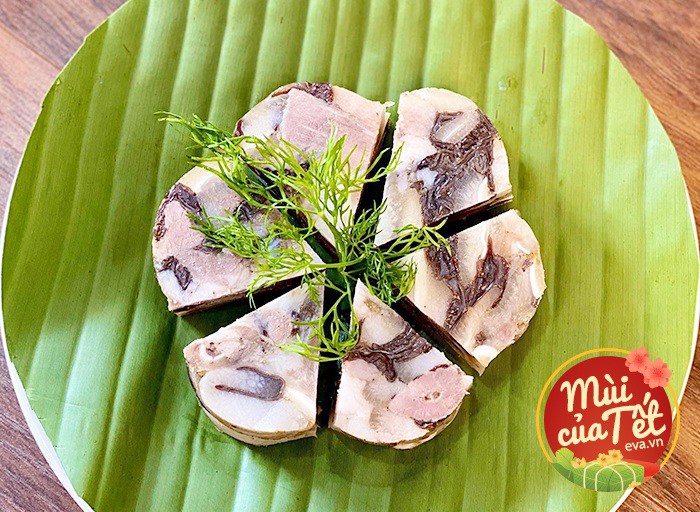
The Vietnamese New Year feast, or Tết, is a celebration of delicious traditional dishes such as boiled chicken, fried spring rolls, pork sausage, bamboo shoots soup, stir-fried pork hocks, and many more. Among these, stir-fried pork hocks stand out for their unique crunchy texture and aromatic flavor, making them a favorite among many.
You can easily prepare this mouthwatering dish at home for your family to enjoy. However, to ensure the best results, keep in mind these five essential tips:
Selecting the Right Ingredients for Stir-Fried Pork Hocks
As you may know, the primary ingredients for this dish typically include pork hocks, ears, and tongue.

– Pork Ears: For the best results, opt for clean, white ears, avoiding any that appear dark or greenish. Stay away from those with excessive fat.
– Pork Tongue: Choose tongues with a bright red, vibrant color, and a white section near the throat. Once cleaned, it should have a distinct aroma, free from any unpleasant odors.
– Pork Hocks: Select fresh, vibrant red-pink hocks with good elasticity and no water leakage. These will add a nice crunch and help bind the dish together without making it dry or crumbly.
Additionally, enhance the flavor by including mushrooms, wood ear fungus, peppercorns, shallots, and fish sauce. Always choose the freshest and highest-quality ingredients for an exceptional dish.
Preliminary Preparation
– As the tongue comes into direct contact with food, it tends to have a strong odor. It’s best to scald it in boiling water to facilitate cleaning, then scrape off the white coating on the surface.
– Remove any hair from the hocks and ears, then rub them with a mixture of lemon juice, white alcohol, and a pinch of salt to eliminate any unpleasant smells before rinsing.
– For the ears, use a knife to make small incisions in the holes at the base of the ear, where dirt tends to accumulate. Rinse thoroughly to remove any remaining impurities.
– Boil a pot of water with a spoonful each of vinegar and salt. Briefly blanch all the meats for about 2 minutes to ensure they’re clean and fragrant.
Marination
Remove the meats from the pot and rinse them in cold water to get rid of any scum and prevent discoloration. Cut the meats, ears, and tongue into thin slices, then marinate them with a pinch of salt, pepper, and fish sauce for about 30 minutes.
Soak the mushrooms and wood ear fungus in warm water to rehydrate them, then clean and chop finely. Peel and mince the shallots.
Stir-Frying the Ingredients
Sauté the shallots until fragrant, then add the meats and stir-fry until they change color. Toss in the mushrooms and wood ear fungus, seasoning with fish sauce to taste. Continue cooking until all the ingredients are well-done and infused with flavor. Finally, sprinkle in some pepper, give it a good stir, and turn off the heat.

Pressing the Stir-Fried Pork Hocks
– Start by cleaning your pork hock mold and letting it air dry.
– For an extra touch of freshness, line the mold with clean banana leaves.
– Fill the mold with the hot stir-fried mixture, tightening the screw by hand. It’s crucial to use hot ingredients to ensure the mixture binds together nicely, resulting in a cohesive dish that isn’t dry or crumbly. The tighter the mixture is packed, the chewier and more enjoyable the final product will be.
– Allow the mold to cool, then refrigerate it for about 8 hours or overnight. This will help the stir-fried pork hocks set, becoming firmer and easier to slice.

Happy cooking, and may your stir-fried pork hocks turn out delicious!
The Secret to Keeping Pork Fresh: Don’t Refrigerate, Try This Marinade Instead
For years, there has been a common misconception that freezing pork directly will result in tough and dry meat. However, a seasoned chef has revealed a secret technique that guarantees fresh and tender pork every time. Unveil the mystery behind this age-old trick and discover the key to unlocking the true potential of your pork dishes.
“Pork Rinse: A Clean and Tasty Transformation”
Introducing: The Ultimate Guide to Safe Pork Handling and Preparation.
You’ve probably heard the age-old advice to always wash your pork before cooking it. But did you know that this common practice could actually be doing more harm than good? It’s time to unravel the truth and discover the right way to handle and prepare pork.
Stay tuned for a comprehensive guide that will transform the way you think about pork preparation. From understanding the risks associated with improper handling to mastering the art of safe and delicious cooking, we’ll cover everything you need to know to become a pork-prep pro.
The Ultimate Guide to Spicing Up Your Meat: 3 Spices to Avoid for a Delicious Broth
“Boiled meat is a popular dish due to its simplicity and delicious flavor. However, there are three key seasonings that should be avoided when boiling meat to preserve its taste. These seasonings can overpower the natural flavors of the meat and ruin the dish. By excluding these ingredients, you can ensure a tasty and appetizing meal every time.”






































